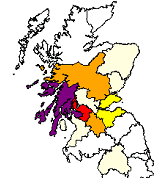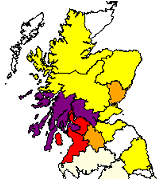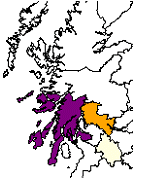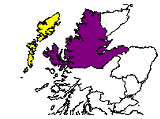![[Clan Crest]](images/Crest%20Colour130.jpg)
Clan MacLea - Livingstone
The Official Home of the Clan McLea (The ancient historical name of the Livingstones)


Livingston(e) / MacLea(y) Name Distribution
This paper looks at the distribution of people using variations of the Livingstone/McLea names in the 1881 census. Use is made of a Surname Project undertaken by University College London (UCL) which has “investigated the distribution of surnames in Great Britain, both current and historic, in order to understand patterns of regional economic development, population movement and cultural identity”.
It is this population movement, as it impacts on our clan, in which I am interested.
As might be expected, the main strength of Clan MacLea was in Lorn, and centred on the old abbey lands of Lismore and Appin (see Cadets). There was a large grouping around Loch Etive where may be found MacLea of Achnacree, MacLea of Lochnell (who had the forty merk land of Lochnell) and MacLea of Achnacloich (Stonefield) in Muckairn.
The MacLeas of Achnacree seem to have been the principal cadets, owning substantial tracts of land on the North Shore of Loch Etive from Achnacree at the Mouth of the Loch in Benderloch right up to Dalness, near Glencoe. In 1557 they were nearly wiped out, losing 80 men while supporting the MacDougalls of Lorn against the Campbells of Inverawe in a clan battle. There is further evidence to support the view that McLea is derived from McDunsleibhe as we can see an example in the Taymouth register which refers in 1557 to John M'Dunslaif of Achnacre .. In later documents this becomes McLea of Achnacree and in turn becomes Livingstone of Achnacree. The McLeas certainly at one time possessed Achnacree in the Benderloch and although once again in the hands of Livingstones they were lost for a time.
A second grouping emerged in Cowal: the McLeas of Lindsaig descend from the MacLeas of Achnacree. On 26 December 1634 Archibald M'Enlay obtained from Lord Lorn a precept infefting him in the six merk land of Lindsaig in Cowal overlooking Loch Fyne near Otter. McLea of Achnaskioch held a five merk land property in Cowal. For several generations they were Physicians in Ordinary to the Lamonts of Inveryn. A younger son of the McLeas of Lindsaig moved to Rothesay in Bute . Much of this is recorded in the McLea manuscript which was written in 1743 by Mr. Duncan McLea, Minister at Dull, and furnished by Doctor Archibald McLea, Minister at Rothsay, his son, 26 May, 1806
A third grouping settled in Strathconnon. It is believed that these Macleas migrated north to Contin in 1469 when they were displaced by the Stewarts of Appin. The Contin lands were in turn lost when a MacLea of Strathconnon died leaving no male heir and the Earl of Seaforth married the heiress. The MacLeas of Achilty were overwhelmed in the Great Battle of Bealach nam Broig in 1452.
I recently corresponded with David Sellar, Bute Pursuivant of Arms who wrote “I think I was mistaken as regards the Macleays of the North: the late Willie Matheson (perhaps the greatest 20th century Highland genealogist) told me that he disagreed with me about this, and I think that, as so often, he was right. Whether or not these northern Macleays are related to the Argyllshire Macleays, it would seem that they did indeed take their surname from an ancestor named “Donnsleibhe”, and not, as I suggested, from one of the Beaton physicians.”
A fourth group is described in the MacLea manuscript “Others also of them call and design themselves Gorm, the first of them that came to Perthshire having had that designation and yet also own themselves Livingston and that they are come of the MacLeas of Argyleshire.”
Thus the historic picture would suggest that we would see the main concentration of the clan around Lismore, Appin and Oban. Descendants of these are known to have migrated south to Cowal and Bute. It is also believed, but not documented, that Macleas migrated north to Contin in 1469.
The Surname Project shows research conducted by Professor Paul Longley, Professor Richard Webber and Dr Daryl Lloyd of University College London (UCL) that investigated the distribution of surnames in Great Britain, both current and historic.
From these I have extracted this data
| Name | 1881 | 1998 | Change |
| Livingstone | 2784 | 4974 | 2190 |
| Livingston | 2712 | 1629 | -1083 |
| MacLeay | 117 | 110 | -7 |
| MacLay | 0 | 0 | |
| Total | 5613 | 6713 | 1100 |
This table shows the overall usage of the names
| Name | 1881 | 1998 |
| Livingstone | 50% | 74% |
| Livingston | 48% | 24% |
| MacLeay | 2% | 2% |
In 1881 there is a roughly even split Livingston/Livingstone but by 1998 there is a 3:1 advantage to Livingstone. This is most likely caused by name change. More people are using the ‘e’.
In 1811 the geographical distribution of the three main names is almost identical, which would confirm my view that they were interchangeable.
 |
 |
 |
Livingston |
Livingstone |
MacLay |
The densest area is the purple – ie around the clan home of Lismore and the old abbey lands. There is not a great deal of information on the MacLay name but once again it centres around Lismore. There is a negligible cluster around the lowland towns of Livingston or Linlithgow which seriously questions whether there were ever any significant numbers of "lowland Livingstons".
| The MacLeay’s in 1881 are very small in number (only 2% of the total Livingston/Livingstone/MacLeay population) and are centred around Inverness. |  |
This distribution is exactly what we would expect from the information already known to us.
Furthermore the clan follows the chief in the name change – and
the closer the people are Lismore the more follow the change.